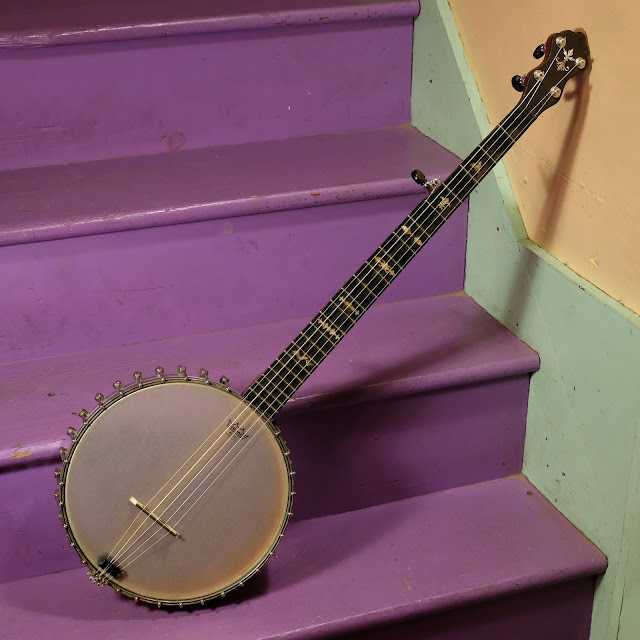1900s Supertone-Style 5-String Openback Banjo
This is a really nice example of this type of banjo and it came to me via a local repair customer. Usually these bear a Sears Supertone label or some random distributor name on them, though I still think they're probably lower-end Lange products, though I can't prove that. This one's a little prettier overall (check out the nice inlay in the fretboard) and has a slimmer, faster neck made from cherry rather than poplar or maple.
The metal-clad rim (with both top and bottom edges rolled-over to make an integral tonering on the top edge) is undersized a little at 10 3/4" but it does have a normal, long scale length. This instrument probably dates from the 1890s but I'll be conservative and call it a 1900s banjo. It would've been made for gut when new (and, really, the neck's cut so fast that I wouldn't use steel on it just on principle) and so I've strung it with Aquila Nylgut strings.
Tonewise, it's full and surprisingly loud. I really like the tone on this. It's not as crisp as a period SS Stewart or Weymann, but it's got a lot of soul and directness about it.
Work included: a fret level/dress, new Remo Renaissance head install, side dots install, new Gotoh 4:1 tuners, a new 5/8" bridge, an extra neck-bolt install, and a thorough setup. Because of the extra bracing for the neck and heel, it's a rock-steady and stable instrument. Action is bang-on 3/32" at the 12th fret and the neck is straight. The frets have some decent life left in them, too.
Scale length: 26 1/4
Nut width: 1 3/16"
String spacing at nut: 15/16"
String spacing at bridge: 1 11/16"
Nut width: 1 3/16"
String spacing at nut: 15/16"
String spacing at bridge: 1 11/16"
Head diameter: 10 3/4" with new Remo Renaissance head
Side depth: 2 1/2"
Rim wood: cherry or maple?
Neck wood: cherry
Fretboard: ebonized maple
Neck wood: cherry
Fretboard: ebonized maple
Neck shape: flat board with slim C/V soft rear shape
Bridge: maple/ebony 5/8" new
Nut: original ebony
Tonering: rolled-over nickel-plated-brass cladding
While this had original celluloid friction pegs, these Gotoh tuners are a far better choice for daily use... they're smooth and excellent quality and won't slip as the weather changes.
The metal-rod neck brace is an interesting feature I only see once in a while on non-Stewart instruments.
All of the rim hardware is original save one hook/nut set from my bins.
I like that original Elite tailpiece! The foam I've added both mutes the string-afterlength overtones and slightly damps the head for a mellower tone.
















Comments